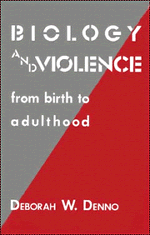Book contents
- Frontmatter
- Contents
- Foreword by Marvin E. Wolfgang
- Preface
- Introduction
- 1 Biological and environmental influences on crime
- 2 Violent criminals as children and as adults
- 3 Intelligence and crime
- 4 Biological and environmental predictors of crime
- 5 Case studies of violent and career criminals
- 6 Biology and responsibility
- Appendix: Selection and distribution of Biosocial Project variables
- References
- Author index
- Subject index
1 - Biological and environmental influences on crime
Published online by Cambridge University Press: 04 August 2010
- Frontmatter
- Contents
- Foreword by Marvin E. Wolfgang
- Preface
- Introduction
- 1 Biological and environmental influences on crime
- 2 Violent criminals as children and as adults
- 3 Intelligence and crime
- 4 Biological and environmental predictors of crime
- 5 Case studies of violent and career criminals
- 6 Biology and responsibility
- Appendix: Selection and distribution of Biosocial Project variables
- References
- Author index
- Subject index
Summary
The domination of sociological explanations of crime and violence is attributable, in part, to a strong environmentalist approach in criminological research and theory. To this date, criminology textbooks provide either no discussion of biological research whatsoever or only a scattered page or two of the more explosive theories (Elliott, 1988).
The review that follows discusses some selected findings in both biological and environmental research on crime, giving a perspective and a description of those variables examined in this study and providing some background for a discussion of the study's results. More extensive reviews of the relationship of crime to genetic, biological, and psychological variables as well as of the various biosocial theories of crime proposed over the years have been provided in a number of recent books and articles (see, e.g., Denno, 1984, 1985, 1988; Elliott, 1988; Mednick et al., 1982, 1987; Moffitt, in press; Moyer, 1987; Shah and Roth, 1974; Siann, 1985; Wilson and Herrnstein, 1985). The following discussion does provide greater detail regarding certain biological and psychological variables, however, because of the dominance of existing reviews of sociological and environmental correlates of delinquency and crime in criminological journals and textbooks (see, e.g., Hirschi, 1969; Kornhauser, 1978). The discussion concludes with a model that integrates links among the variables and disciplines to present a probability theory of behavior for explaining serious, repeat delinquency.
- Type
- Chapter
- Information
- Biology and ViolenceFrom Birth to Adulthood, pp. 7 - 28Publisher: Cambridge University PressPrint publication year: 1990



